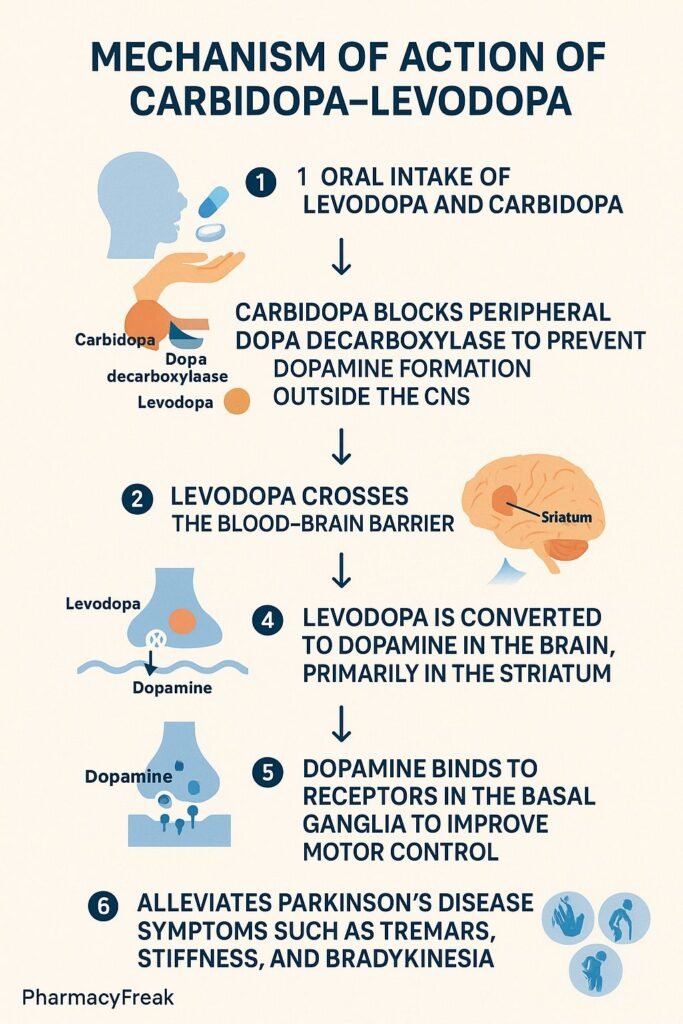Table of Contents
Introduction
Carbidopa–Levodopa is a cornerstone therapy in the management of Parkinson’s disease. Levodopa serves as a precursor to dopamine, replenishing depleted levels in the brain, while carbidopa prevents premature peripheral metabolism of levodopa, ensuring its availability in the central nervous system. Together, they effectively improve motor symptoms such as bradykinesia, rigidity, and tremor.
Step-by-Step Mechanism of Action
- Oral Absorption of Levodopa
Levodopa, when administered orally, is absorbed in the small intestine and enters the systemic circulation. - Prevention of Peripheral Conversion
Carbidopa inhibits the enzyme aromatic L-amino acid decarboxylase (AADC) in peripheral tissues, preventing the premature conversion of levodopa into dopamine outside the brain. - Increased CNS Availability
By inhibiting peripheral metabolism, carbidopa allows a higher concentration of levodopa to cross the blood-brain barrier and reach the central nervous system. - Conversion to Dopamine in the Brain
In the brain, levodopa is decarboxylated by central AADC into dopamine, primarily in the striatum, replenishing the deficient neurotransmitter in Parkinson’s disease. - Activation of Dopaminergic Pathways
The newly formed dopamine stimulates D1 and D2 receptors in the basal ganglia, improving the balance between the direct and indirect motor pathways, leading to improved motor control. - Symptom Relief
This results in alleviation of motor symptoms such as bradykinesia, rigidity, and tremors.

Pharmacokinetic Parameters
| Parameter | Value |
|---|---|
| Route | Oral |
| Levodopa Bioavailability | ~30% |
| Carbidopa Bioavailability | ~58% |
| Levodopa Half-life | 0.75 to 1.5 hours |
| Carbidopa Half-life | ~2 hours |
| Metabolism | Levodopa: Decarboxylation; Carbidopa: Enzyme inhibition |
| Excretion | Renal (as metabolites) |
Clinical Uses
- Parkinson’s disease (primary indication)
- Parkinsonism due to other causes (e.g., encephalitis, carbon monoxide poisoning)
- Dopamine-responsive dystonia
Adverse Effects
- Peripheral: Nausea, vomiting, orthostatic hypotension, arrhythmias
- Central: Dyskinesias, hallucinations, confusion, motor fluctuations (“on-off” phenomena)
- Long-term use may result in wearing-off effects and dose-related complications.
Comparative Analysis
| Drug Component | Mechanism | Clinical Role |
|---|---|---|
| Levodopa | Dopamine precursor | Replaces dopamine in the CNS |
| Carbidopa | AADC inhibitor (peripheral) | Prevents levodopa’s peripheral breakdown |
MCQs
1. Carbidopa inhibits which enzyme?
a) MAO-B
b) COMT
c) AADC
d) DOPA hydroxylase
Answer: c) AADC
2. The primary benefit of adding carbidopa to levodopa is to:
a) Enhance dopamine receptor sensitivity
b) Inhibit dopamine synthesis in the brain
c) Prevent peripheral conversion of levodopa
d) Increase hepatic metabolism
Answer: c) Prevent peripheral conversion of levodopa
3. Levodopa crosses the blood-brain barrier via:
a) Passive diffusion
b) Dopamine transporter
c) L-amino acid transporter
d) Active glucose transporter
Answer: c) L-amino acid transporter
4. The site of levodopa’s therapeutic action is:
a) Cerebellum
b) Hippocampus
c) Striatum
d) Medulla
Answer: c) Striatum
5. The “on-off” phenomenon is related to:
a) Sudden cardiac arrhythmia
b) Fluctuating therapeutic response to levodopa
c) Respiratory depression
d) GABAergic inhibition
Answer: b) Fluctuating therapeutic response to levodopa
6. Dopamine formed from levodopa primarily stimulates:
a) Alpha-adrenergic receptors
b) GABA-A receptors
c) D1 and D2 receptors
d) NMDA receptors
Answer: c) D1 and D2 receptors
7. Why is levodopa not used alone in Parkinson’s therapy?
a) It is poorly absorbed
b) It causes severe hallucinations
c) It is rapidly metabolized peripherally
d) It lacks CNS action
Answer: c) It is rapidly metabolized peripherally
8. Carbidopa reduces which adverse effect of levodopa?
a) Dyskinesia
b) Nausea
c) Hallucinations
d) Insomnia
Answer: b) Nausea
9. The effect of levodopa on tremors is due to:
a) Inhibition of serotonin
b) Enhanced cholinergic tone
c) Restoration of dopaminergic signaling
d) Calcium channel blockade
Answer: c) Restoration of dopaminergic signaling
10. What is a long-term complication of levodopa therapy?
a) Constipation
b) Dyskinesia
c) Liver cirrhosis
d) Hyperkalemia
Answer: b) Dyskinesia
FAQs
1. Why are carbidopa and levodopa given together?
To enhance the effectiveness of levodopa in the brain by preventing its breakdown in peripheral tissues.
2. Can carbidopa–levodopa be used long-term?
Yes, but long-term use may lead to motor complications and require dose adjustments.
3. Does this combination cure Parkinson’s disease?
No, it only provides symptomatic relief without altering disease progression.
4. Can dietary proteins affect levodopa absorption?
Yes, high-protein meals can compete with levodopa for intestinal absorption.
5. Is dose titration needed?
Yes, doses are individualized to minimize side effects and manage motor symptoms.
References
- Goodman & Gilman’s: The Pharmacological Basis of Therapeutics, 13th Edition
- KD Tripathi: Essentials of Medical Pharmacology, 8th Edition
- PubMed: Levodopa pharmacokinetics
- DrugBank: Levodopa and Carbidopa
- Drugs.com: Carbidopa–Levodopa Monograph

I am pursuing MBA in pharmaceutical management from NIPER Hyderabad with a strong academic record and proven success in national-level pharmacy entrance exams. I secured AIR 61 in NIPER 2024 (MS/M.Pharm) and AIR 27 in NIPER MBA, along with AIR 147 in GPAT 2024 and AIR 907 in GPAT 2023. I also achieved AIR 6 in AIIMS CRE-2025 for Drug Store Keeper and was selected as a Pharmacist (AIR 61) for ESIC. Additionally, I was the Runner-Up in Round 2 of the EY Case Study Competition.
At PharmacyFreak.com, I aim to guide future pharmacists through expert content, exam strategies, and insightful resources based on real experience and academic excellence.
Mail- harsh@pharmacyfreak.com
